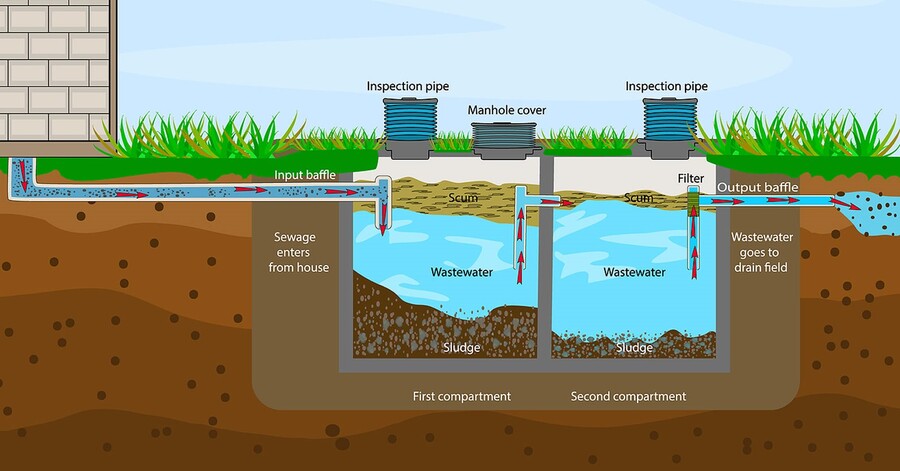Call This Monday to Get $25 OFF
Clean Solutions, Dirty Jobs – Done Right. Reliable. Responsive. Remarkable.
Call This Monday to Get $25 OFF
Clean Solutions, Dirty Jobs – Done Right. Reliable. Responsive. Remarkable.
Aerobic septic systems are a modern and efficient alternative to traditional septic systems for wastewater treatment. These systems use aeration to speed up the decomposition of organic matter and enhance the treatment process. At Septic Connection, we understand the working principles of aerobic septic systems, ensuring proper septic tank installation and maintenance.

Aerobic septic systems, also known as aerobic treatment units (ATUs), treat wastewater from households and commercial establishments. Unlike conventional septic systems that rely on anaerobic bacteria for decomposition, aerobic systems introduce oxygen into the treatment process, promoting the growth of aerobic bacteria. This leads to a more efficient breakdown of organic matter and a higher level of treatment. Before you schedule a professional septic tank installation with a reputable septic company, let’s look at the working mechanism.
The heart of an aerobic septic system is the aeration chamber. This chamber infusing oxygen into the wastewater. Oxygen is vital for the growth and sustenance of aerobic bacteria, which are highly effective at breaking down organic materials. Aeration is typically achieved through various methods, such as diffusers, pumps, or mechanical aerators.
Once oxygen is introduced, aerobic bacteria thrive and multiply. These bacteria use the organic matter present in the wastewater as their food source. As they metabolize this material, the bacteria produce carbon dioxide, water, and additional bacterial cells. This process reduces the concentration of harmful contaminants in the wastewater. This also goes a long way to minimize waste buildup and costly septic tank repair services.
The septic system is an onsite waste treatment facility, and it is incredibly reliable. However, the system is only as effective…
Imagine flushing your toilet and then suddenly realizing that your backyard has turned into a swampy mess. This unpleasant experience is…
Soil testing is a critical step in various construction and environmental projects. It provides essential information about the ground conditions, which…
Grease traps are remarkable tools that help keep your establishment clean and free from bad odors. Septic Connection has a…
If you have just moved into a new home or property that relies on a septic system for waste and wastewater…
After the wastewater has undergone treatment in the aeration chamber, it enters a clarification or settling chamber. The bacterial cells and other suspended solids settle at the bottom of the chamber. The treated water, which is more precise and cleaner, moves on to the next stage of the treatment process.
In some advanced aerobic septic systems, a disinfection step follows the settling chamber. This step involves further treatment to eliminate any remaining pathogens or harmful microorganisms. Disinfection can be achieved through chlorination or ultraviolet (UV) light exposure.
Consider a more efficient system if you rely on an anaerobic system or require frequent septic tank repair inspections. Here are the benefits of aerobic septic units in waste management.
Oxygen and the growth of aerobic bacteria fasten the decomposition of organic matter. This results in a higher level of treatment compared to conventional septic systems. It also minimizes the frequency of septic tank pumping without compromising performance.
Aerobic systems produce effluent that is cleaner and less harmful to the environment. The enhanced treatment process reduces the risk of groundwater contamination and surface water pollution. However, routine inspections by a professional septic company are vital for addressing minor issues and ensure everything is in tip-top shape.
Aerobic systems can be installed in various soil types, including those with poor drainage. This makes them suitable for areas where traditional septic systems might need to be more effective.
Aerobic septic systems offer a modern and efficient solution for wastewater treatment. By harnessing the power of aerobic bacteria and oxygen infusion. As technology advances, these systems will probably play an increasingly important role in sustainable wastewater management practices. Contact us at Septic Connection and access quality services, such as septic tank pumping, repair, and maintenance, without breaking the bank.
Buying a home with a septic system can feel intimidating if you’ve never had one before. Unlike city sewer systems, septic systems rely on regular care and professional service to…
Read moreHosting a big party at your home can be exciting, but it also brings a unique set of challenges, especially when you rely on a septic system. Between extra guests,…
Read more